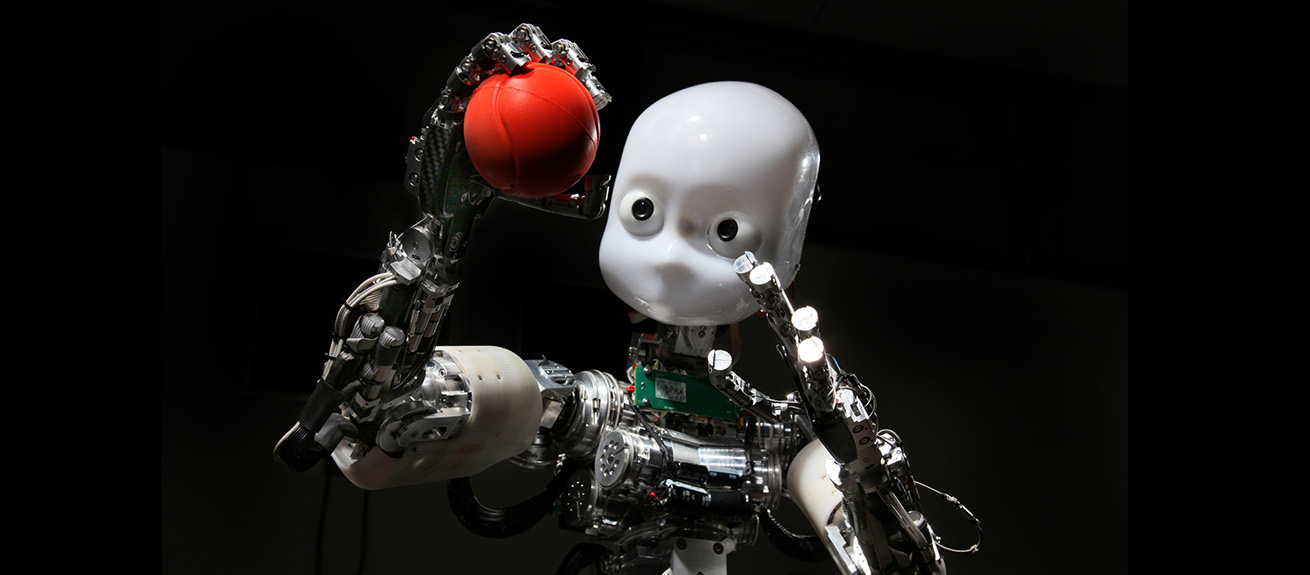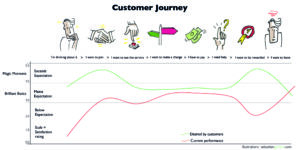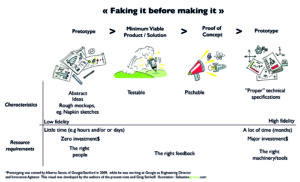Many executives we meet at IMD ask the following question: How can we use the latest technologies – be it the Internet of Things, robotics, artificial intelligence and others – to transform our business?
And our answer is always the same: technology is a means to an end – not an end in itself.
Whether you are trying to deliver new offerings to customers or increase operational efficiencies within the firm, three methodological approaches can be used – design thinking, agile ways of working and, a makers’ mindset – which combined, can deliver excellent value to your business.
The starting point for any technological solution needs to be the customer or end-user. And this is where design thinking comes into play.
Design thinking is a human-centered approach to innovation that fundamentally rests on two essential principles: empathy and objectivity.
Empathy– in order to innovate, you must understand the people you’re trying to serve, the environments and contexts in which they operate, and the interactions they have with the world. Innovation all begins with observation: through empathy, you can identify the problems people experience today as they try to get “jobs” done in their lives or work. It’s important to document your observations carefully: notes, photos, videos, interviews, customer quotes. These should be compiled in a diary that will help you understand what the customer “Does”, “Thinks”, and “Feels”. In turn, these observations will give you insights that can help you identify and prioritize opportunities to innovate.
Objectivity – in this phase, you also want to keep an open mind, and avoid being prisoner of assumptions that might blur your thinking. The challenge for leaders is to act as anthropologists who immerse themselves in the user context to see the world from their perspective – and understand reality as it is, not as they wish it to be.
Take the example of how Ooredoo, a mobile phone company we worked with at IMD. The figure below shows how they map the experience of customers – from when they want to join the mobile phone provider to when they actually leave the relationship. As a starting point, teams visualized the customer experience journey before summarizing what customers expect at each stage and how current organizational performance compares against the expectations of customers.
Through mapping the customer journey, Ooredoo understands how it currently interacts with customers through various touchpoints and what pains, or magic moments, are created in the process. It carefully documents and describes the activities the customer engages in, revealing the unnecessary, extra effort that could be removed to improve satisfaction and achieve an ideal future (or enriched experience) from a customer viewpoint.
Agile ways of working
Figuring out and mapping visually what an ideal future of, for instance, what the customer experience could be, is the starting point for taking an agile approach to working on solutions. Agile ways of working have been around for almost 15 years and have their own philosophy and practices.
The agile approach is intended to emphasize maximizing value creation by de-emphasizing up front specifications and processes (the typical product features a company has offered in the past) in favor of front loading customer value. The value has ideally been derived from the mapping of user journeys and this becomes the starting ground for brainstorming potential solutions. Ultimately, the solution needs to be broken down into how we want the user’s experience to look once our product, service or process improvement is available. This means carefully identifying the tasks users perform, the benefits they want to achieve and then using, for instance, the scrum method to develop the features that users want.
Scrum is an agile, iterative and incremental software development method for managing product or application projects. The term scrum comes from the English game of rugby, where it is a means to restart play after a minor infraction. Scrum is an organized method for both teams to engage with clear rules and procedures to follow. In software development, scrum refers to a holistic project management process which is performed by one cross-functional team across multiple overlapping phases. A product owner represents the voice of the customer and defines and prioritizes features (typically in user stories) that are then added to the product backlog. The development team then implements the chosen features in short, precise cycles: the so called sprints. The result of every sprint is a functioning product that avoids important bugs. Essentially, the agile approach can be applied to developing solutions using technologies such as robotics, internet of things or artificial intelligence to create new products, services or an improved process. So what is the role of a maker’s mindset in this context?
Maker’s mindset
It is often argued that we are living in a makers’ economy where every garage is a potential micro-factory. Potential entrepreneurs are now using the tools of factory production, from electronics assembly to Laser Cutters and 3-D printing, to create physical representations of their innovative ideas and evaluate their reasoning in the market.
To test the underlying assumptions of the technological solutions that you are developing, you can first preto-type with the spirit of “faking it before making it”. Preto-typing often is the first phase of development of the product, service or internal process improvement and differs from proto-typing (see Figure below).
While the more conventional approach of proto-typing involves creating a truthful representation of the actual solution, preto-typing is really about conceptualizing the solution so that you can get easy feedback from users. This is low-cost and fast-moving and could be at the very minimum a sketch on a napkin, with the only requirement being that you get the right people in the room. At this stage, it is NOT about building the actual solution but sharing the “potential” benefits in a way that users can understand what the final product or service could deliver. Pretotypes can thus be seen as low-fidelity mock-ups that elicit feedback. A pretotype should invite criticism and suggestions.
This means we can’t learn from customers and users unless we also get early feedback about the potential solution by asking them the right questions. If you ask the user if the product should be blue or green, you learn little except for their color preference. But if you ask “Tell me a story” – or even “show me how you would use this object if it was green?” you’ll get rich data that helps you move forward in eventually coming up with a better solution to the user’s pain. Preto-typing allows us to better understand the kinds of product features that would need to be designed and implemented. This often requires the creation of user stories that can be summed up by the following:
“As a <type of user>, I want <some benefit> so that I can accomplish <a given task> in a <specific context>.”
The next step is to prioritize these user stories so they can be addressed by an agile project team motivated to deliver the highest possible value to the end user. Pretotyping is often followed by prototyping. Prototyping involves the creation of high-fidelity mockups that more accurately represent the final product, and as such they are more expensive and complicated to build compared to their low-fidelity predecessors.
It’s all about the end user
Design thinking, the agile approach and a maker’s mindset are all focused on having an end user perspective for value creation and people orientation at the center of their approach. They also entail a new way of working which is often fundamentally different from the existing management approach within an organization. Managing projects with a waterfall principle and making decisions only at certain gates when users are involved has to be thrown out of the window for the benefit of empowered teams that keep the focus on delivering value to customers.
Bettina Buechel is Professor of Strategy and Organization. Cyril Bouquet is Professor of Strategy and Innovation. Jim Pulcrano is Adjunct Professor and focuses on entrepreneurship.
They lead IMD’s new program with EPFL: Transform TECH where executives learn how to transform their business with new technology.



![How AI gives Taobao's one billion customers the personal touch [Video]](https://www.imd.org/ibyimd/wp-content/uploads/2024/03/TheInterview-ChrisTung-IbyIMD-TopBanner-5_4-1250x1000-1-720x630.jpg)


